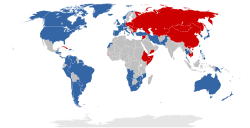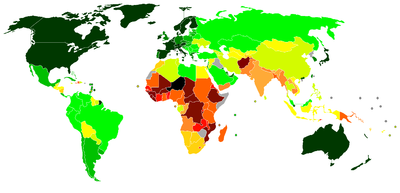Third World

The term Third World arose during the Cold War to define countries that remained non-aligned or neutral with either capitalism and NATO (which along with its allies represented the First World) or communism and the Soviet Union (which along with its allies represented the Second World). This definition provided a way of broadly categorizing the nations of the Earth into three groups based on social, political, and economic divisions. Although the term continues to be used colloquially to describe the poorest countries in the world, this usage is widely disparaged since the term no longer holds any verifiable meaning after the fall of the Soviet Union deprecated the terms First World and Second World. While there is no identical contemporary replacement, common alternatives include developing world and Global South.
The third word means not as developed French demographer, anthropologist and historian Alfred Sauvy, in an article published in the French magazine L'Observateur, August 14, 1952, coined the term Third World, referring to countries particularly in the Middle East, South Asia, Central and South America, Africa, and Oceania, that were unaligned with either the Communist Soviet bloc or the Capitalist NATO bloc during the Cold War. His usage was a reference to the Third Estate, the commoners of France who, before and during the French Revolution, opposed priests and nobles who composed the First Estate and Second Estate. Sauvy wrote, "Like the third estate, the Third World has nothing, and wants to be something," He conveyed the concept of political non-alignment with either the capitalist or communist bloc.
The growing use of the term Third World led to a growing sense of solidarity among the nations of the so-called Third World to unite against interference from either major bloc. In 1955, leaders of 29 countries from Asia and Africa met at the Bandung Conference to discuss cooperation. The First Prime Minister of India, Jawaharlal Nehru, notably said the following: "I have no doubt that an equally able disposition could be made on the part of the other bloc. I belong to neither [the First or Second World] and I propose to belong to neither whatever happens in the world. If we have to stand alone, we will stand by ourselves, whatever happens...
We do not agree with the communist teachings, we do not agree with the anti-communist teachings, because they are both based on wrong principles."[1]
Nehru's speech led several delegates to call for India to lead a "third bloc" composed of the nations of Africa and Asia, however he declined and no other state chose to fill the proposed role.[2]
In addition, Mao Zedong, the Chairman of China Communist Party, in February 22, 1974 with the President of the Republic of Zambia Kenneth Kaunda had said: "I think the United States and the Soviet Union was the first world. Centrist, Japan, Europe, Australia, Canada, is the Second World. We are the Third World. "This definition, basically according to human development index, with the first popular -- Cold War framework focusing on the difference between patterns that subconsciously -- take a completely different point of view.

| Developed 0.950 and Over 0.900–0.949 0.850–0.899 0.800–0.849 | Developing 0.750–0.799 0.700–0.749 0.650–0.699 0.600–0.649 0.550–0.599 0.500–0.549 | Under-developed 0.450–0.499 0.400–0.449 0.350–0.399 under 0.350 not available |
Are commonly considered "Third World" the following world regions:
Africa (except South Africa and Seychelles) , Latin America (except Argentina, Brazil, Chile, Mexico and Uruguay) , Asia (except Japan, Israel, South Korea, Brunei, Singapore, Hong Kong, Macau and Russia)
History

A number of Third World countries were former colonies and with the end of imperialism many of these countries, especially the smaller ones, were faced with the challenges of nation and institution-building on their own for the first time. Due to this common background a lot of these nations were for most of the 20th century, and are still today, "developing" in economic terms. This term when used today generally denotes countries that have not "developed" to the same levels as OECD countries, and which are thus in the process of "developing". In the 1980s, economist Peter Bauer offered a competing definition for the term Third World. He claimed that the attachment of Third World status to a particular country was not based on any stable economic or political criteria, and was a mostly arbitrary process. The large diversity of countries that were considered to be part of the Third World, from Indonesia to Afghanistan, ranged widely from economically primitive to economically advanced and from politically non-aligned to Soviet- or Western-leaning. The only characteristic that Bauer found common in all Third World countries was that their governments "demand and receive Western aid" (the giving of which he strongly opposed). Thus, the aggregate term "Third World" was challenged as misleading even during the Cold War period.
General Description
The Third World is the majority of national powers on the planet. These countries represent a modern society, but in the process of potential development as recognized continental representatives of the world community today. The majority among this group, comprises of many moderately wealthy, but militarily effective governments. To include to this, many Third World nations (especially in Africa), are affected drastically by political problems, or bad geographical conditions, such as droughts and non-fertile soil. These problems are not the least of it in some Third World countries. Famines, shortages, regional wars, and etc., have all caused much instability and no hopes of restoration in the public in Third World nations. Today, the First World, and the Second World, come forth to bring aid and civil support to bring about strong foreign relations, and bring them into any of their collective orbits'. Superpowers, whether asked or self-intended, charitably feed their resources and benefacted commodities to these types of Third World powers[citation needed], ostensibly as a form of idealistic friendship, though the financial institutions through which this "friendship" is extended (e.g., the IMF and World Bank) have been heavily criticized for creating, rather than alleviating, poverty and economic dependence[citation needed]. Many members of the Third World state of national powers, are of course nonaligned with any global significance (like the United States of America), and squander on their various economic or political concerns in regional affairs.
See also
Notes
- ^ Modern History Sourcebook: Prime Minister Nehru: Speech to Bandung Conference Political Committee, 1955. Quoted from G. M. Kahin, The Asian-African Conference (Cornell University Press, 1956), pp. 64–72.
- ^ Thomas, Darryl C. The Theory and Practice of Third World Solidarity. Westport, Conn.: Praeger Publishers, 2001. Template:ISBN-10. Page 72.
Further reading
- Aijaz Ahmad, In Theory: Classes, Nations, Literatures. (1992)
- P. T. Bauer, Equality, the Third World, and Economic Delusion. (1981) ISBN 0-674-25986-6.
- J. Cole, Development and Underdevelopment. (1987)
- A. Escobar, Encountering Development. The Making and Unmaking of the Third World. (1995)
- E. Hermassi, The Third World Reassessed. (1980)
- A. R. Kasdan, The Third World: A New Focus for Development. (1973)
- P. W. Porter and E. S. Sheppard, A World of Difference: Society, Nature, and Development. (1998)
- H. A. Reitsma and J. M. Kleinpenning, The Third World in Perspective. (1985)
- Alan Whaites, States in Development, UK Department for International Development, London 2007, [1]
